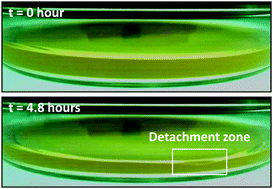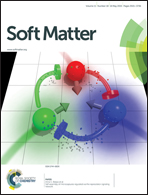Syneresis and delayed detachment in agar plates†
Abstract
Biogels made of crosslinked polymers such as proteins or polysaccharides behave as porous soft solids and store large amounts of solvent. These gels undergo spontaneous aging, called syneresis, which consists of the shrinkage of the gel matrix and the progressive expulsion of solvent. As a result, a biogel originally casted in a container often loses contact with the container sidewalls, and the detachment time is difficult to anticipate a priori, since it may occur over variable time spans (from hours to days). Here we report on syneresis phenomena in agar plates, which consist of Petri dishes filled with a gel mainly composed of agar. Direct observations and speckle pattern correlation analysis allow us to rationalize the delayed detachment of the gel from the sidewall of the Petri dish. The detachment time t* is surprisingly not controlled by the mass loss as one would intuitively expect. Instead, t* is strongly correlated to the gel minimum thickness emin measured along the sidewall of the plate, and increases as a robust function of emin, independently of the prior mass-loss history. Time-resolved correlation spectroscopy atypically applied to such weakly diffusive media gives access to the local thinning rate of the gel. This technique also allows us to detect the gel micro-displacements that are triggered by water evaporation prior to the detachment, and even to anticipate the latter from a few hours. Our work provides observables to predict the detachment time of agar gels in dishes, and highlights the relevance of speckle pattern correlation analysis for the quantitative investigation of the syneresis dynamics in biopolymer gels.


 Please wait while we load your content...
Please wait while we load your content...